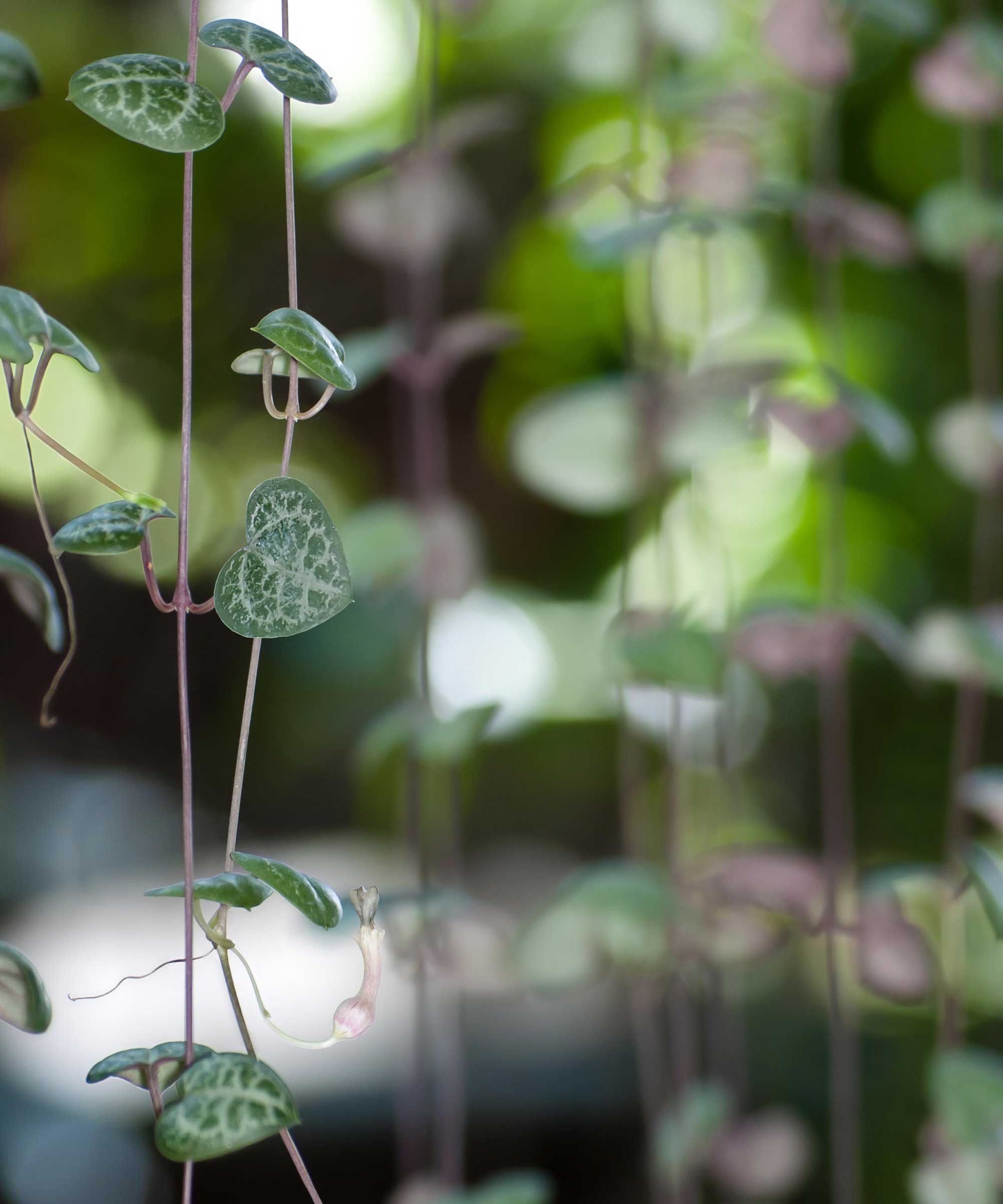String-of-hearts care and growing guide – top tips for these trailing houseplants
Our string-of-hearts care advice will keep these dainty plants looking beautiful all year round


Delicate thread-like stems covered with heart-shaped green and cream patterned leaves make the string-of-hearts (Ceropegia woodii) a firm favorite with houseplant parents. These South African natives not only look beautiful but are also very easy to care for, adding to their charms, and will provide a cascade of color in the smallest of rooms, given the right conditions.
Also known as the rosary vine due to the little round beadlike tubers that sometimes develop along the stems, in late spring and summer this evergreen succulent also produces unusual tubular pink and purple flowers that smell of nutmeg.
Their trailing stems make them one of the best indoor plants for placing up high, and a happy plant will grow vigorously up to 6ft or more in length. You can also trim the stems from the bottom if they get too long, and use these cuttings to make new plants. Just remove some of the leaves from the trimmed ends, pop them in a glass of water, and pot them up when new roots emerge, following the care advice below to grow them on.

These plants will pep up an indoor scheme

Zia Allaway is a highly experienced garden book author, editor, and journalist, covering a wide range of gardening topics in her work. She has also written a number of books, including several on houseplants such as The RHS Practical House Plant Book and Practical Cactus & Succulent Book, both available on Amazon.
Where to place string-of-hearts
When caring for succulents, such as string-of-hearts, it's important to provide the right lighting conditions. Adam Besheer, Co-owner of New York-based online houseplant shop and retail store Greenery Unlimited says, 'These plants are tolerant of slightly lower light conditions than some succulents and may not need to be placed directly beside a window, especially in a south-facing room, where they will survive on a shelf or other elevated surface a few feet away.'
If you do place them on a sunny sill, move them away from it from early summer to early fall to prevent the leaves from scorching.
These plants do not require high levels of humidity to thrive and will be happy in a living or dining room, or as a bedroom plant. String-of-hearts tolerate a wide temperature range of between 46 and 86˚F.

Place it up high to allow the stems to trail
How to water and feed string-of-hearts plants
Overall, string-of-hearts are a relatively low-maintenance indoor plant. Daniel Jackson, the owner of multi-award-winning UK-based nursery Ottershaw Cacti, says that while string-of-hearts like a good drink, they should be left to dry out between waterings.
Design expertise in your inbox – from inspiring decorating ideas and beautiful celebrity homes to practical gardening advice and shopping round-ups.
'When your plant is growing rapidly in the spring and summer months, water it about every 7-10 days when the top of the compost feels completely dry; water less frequently if it’s in a humid environment such as a bathroom. And in winter, when growth is slow, reduce watering to about once a month, or just enough to prevent the leaves from shriveling.'
You won’t need to mist your plant, but it will benefit from a dose of low-nitrogen fertilizer for succulents about once a month from spring to early fall, which will encourage flowering, too. 'We also repot our plants once a year, or once every two years, in a 3:2 combination of peat-free soil-based potting mix and horticultural grit,' adds Daniel.

String-of-hearts gets its name from its pretty, heart-shaped leaves
Key problems with string-of-hearts
The most common problem with a string-of-hearts is overwatering. Soggy potting soil can lead to yellowing of the leaves and root rot, which could potentially kill your plant.
To avoid this, plant your succulent in a pot with drainage holes and a removable base or saucer (there are lots available on Amazon). When it’s time to water the plant, place it in the sink. Give it a good drink, so that the potting soil is moist through, and then leave it to drain before putting it back on display. Adam adds: 'Underwatering is not as common a problem, but if the plant is left to dry out completely in summer, it can rapidly defoliate.'
The easy-care string-of-hearts suffers from few other problems and is rarely attacked by pests or diseases. Mealybugs and red spider mites occasionally cause problems, so check your plants regularly for signs of these sap-sucking insects, which may distort or discolor the leaves. Mealybugs are woodlice-like creatures that hide beneath a fluffy white coating while the tiny spider mite causes white mottled patches on the foliage.
If the bugs are only affecting a few stems, the easiest solution for the fast-growing string-of-hearts is to remove any affected growth to prevent an infestation. Alternatively, you may be able to wipe off mealybugs with a damp cloth. To treat a heavy attack of spider mites, try a biological control, which you can order online. Organic sprays based on natural pyrethrum or plant oils can also help to control mealybugs and red spider mites.

As a low-maintenance plant, string-of-hearts is a good choice for beginners
Should you untangle a string-of-hearts?
Even if you allow plenty of space for your string-of-hearts to grow, the stems can sometimes become tangled.
Daniel Jackson advises not trying to untangle the delicate stems, which may break in the process. He adds: 'I have found untangling is a waste of time, too, since the stems just knot together again soon afterward. So rather than damaging them, I would leave them alone and just accept their slightly disheveled look.'
Is string-of-hearts pet friendly?
String-of-hearts are pet-friendly houseplants as they are non-toxic to them. 'However, they are very fragile plants and easily damaged, so it's best to keep them out of reach of children or pets,' Adam says.
Cats like to play with the long stems, too, and may pull down plants from their perches.

Sometimes, these indoor plants produce flowers
Where can you buy string-of-hearts plants?
These indoor plants are widely available. Adam sells them at his store in Brooklyn but says you probably won't find them at big box stores, so ask at your local houseplant nursery who may be able to order one for you if they don’t have any in stock.
You can also purchase them at these online stockists:

Zia Allaway is a garden book author, editor, and journalist, and writes for a range of gardening and women’s magazines, including Easy Gardens, Homes & Gardens and Livingetc, as well as The Guardian and The Daily Telegraph newspapers. She has also written books for the Royal Horticultural Society and Dorling Kindersley publishers, including Eco-Gardening, Compost, Low Maintenance, Practical House Plant Book, Practical Cactus & Succulent Book, Indoor Edible Garden, What Plant Where, and the Encyclopedia of Plants and Flowers.